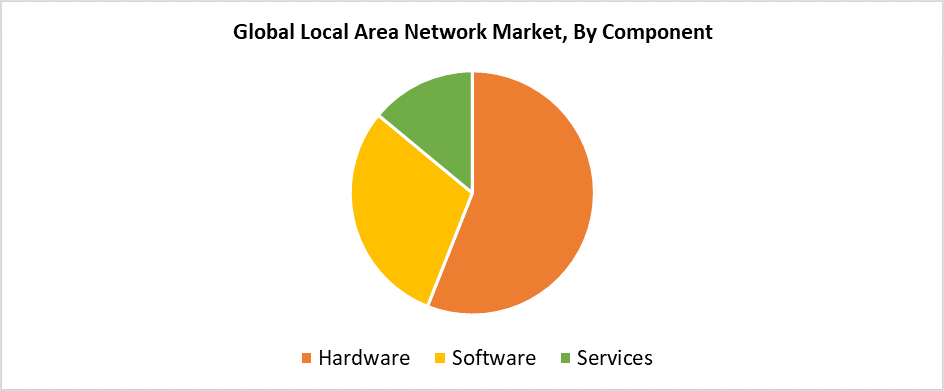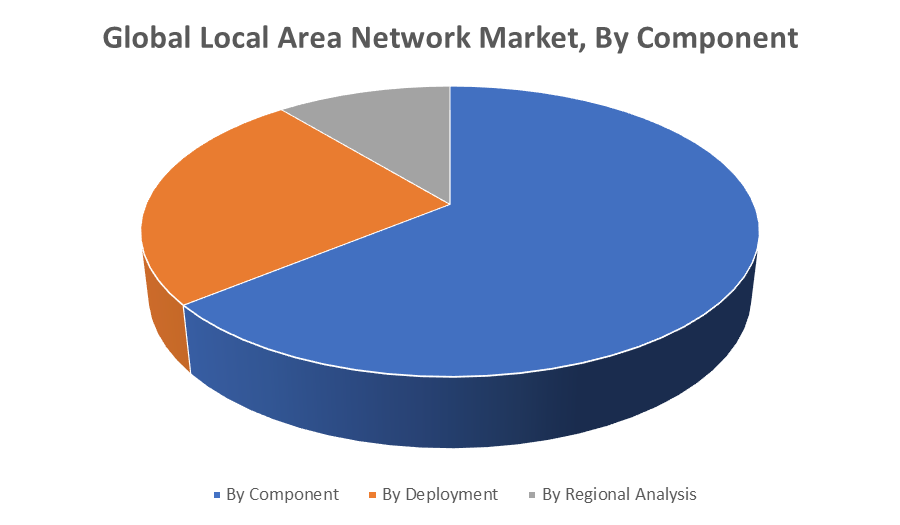Global Local Area Network Market
Global Local Area Network Market Size, Share, and COVID-19 Impact Analysis, By Component (Hardware, Software, Services), By Deployment (Wired LAN, Wireless LAN, Hybrid LAN), and By Region (North America, Europe, Asia-Pacific, Latin America, Middle East, and Africa), Analysis and Forecast 2025 - 2035
Report Overview
Table of Contents
Local Area Network Market Summary
The Global Local Area Network Market Size Was Estimated at USD 92.02 Billion in 2024 and is Projected to Reach USD 155.36 Billion in 2035, Growing at a CAGR of 4.88% from 2025 to 2035. The market for local area networks (LANs) is expanding as a result of growing internet usage, digitalization, the need for high-speed connectivity, the adoption of smart devices, cloud computing, remote work trends, and enterprise infrastructure growth.

Key Regional and Segment-Wise Insights
- In 2024, North America held the greatest revenue share of 35.42% in the local area network (LAN) market.
- In 2024, the hardware segment held the biggest revenue share of 56.47%, leading the market by component.
- In 2024, the wired LAN segment dominated the market by deployment, with the largest revenue share of 54.37%.
Global Market Forecast and Revenue Outlook
- 2024 Market Size: USD 92.02 Billion
- 2035 Projected Market Size: USD 155.36 Billion
- CAGR (2025-2035): 4.88%
- North America: Largest market in 2024
- Asia Pacific: Fastest growing market
The LAN market comprises the infrastructure and hardware, as well as software systems, that connect computers and devices within limited geographic areas, including business premises, educational facilities, and campuses. Organizations utilize LANs to transfer data efficiently, enabling communication and resource sharing. The LAN market expansion results mainly from sector-wide digital transformation, rising high-speed data needs, cloud service adoption, and growing Internet of Things (IoT) connected devices. The market continues to grow because businesses and academic institutions require efficient communication platforms and teamwork solutions. The shift toward remote and hybrid work environments has driven increased demand for trustworthy local network infrastructures.
The LAN market experiences major changes from technological advances. Wi-Fi 6 and 6E technologies enhance wireless LAN performance by delivering higher capacity alongside reduced latency and faster speeds. Network optimization receives growing attention from researchers who want to merge machine learning and artificial intelligence approaches. Government investments in smart city projects and digital infrastructure across the world drive the development of local networks and broadband availability. The U.S. Broadband Equity program and Digital India initiative help establish extensive LAN deployment in all residential communities, from cities to the countryside.
Component Insights

The hardware segment dominated the Local Area Network (LAN) market with the highest revenue share of 56.47% in 2024. The market expansion primarily stems from rising requirements for network infrastructure parts, including switches, routers, access points, network interface cards (NICs), and cables. Modern businesses require dependable and effective hardware solutions for their IT infrastructure modernization projects, which focus on increasing bandwidth and connectivity capabilities. The rapid growth of data centers, together with cloud services and smart gadgets, drives additional market demand. The hardware segment maintains its leading industry position because advanced Wi-Fi 6 and 6E technology implementation drives demand for sophisticated hardware, which supports bigger data rates and increased device connections.
The Local Area Network (LAN) market's software is anticipated to grow at the fastest CAGR throughout the forecast period. Organizations and institutions adopt network management and monitoring software together with security software to drive this market growth. Network infrastructures now require intelligent software to deliver efficient performance, automation, and cybersecurity because of their increasing complexity from IoT implementation, cloud computing, and remote access solutions. Network virtualization and software-defined networking (SDN) have grown in popularity to provide businesses with enhanced flexibility and scalability, together with centralized management capabilities. The demand for real-time analytics, together with predictive maintenance and AI-driven network optimization, has driven the rising adoption of advanced LAN software solutions.
Deployment Insights
The wired LAN segment dominated the highest Local Area Network (LAN) market with the largest revenue share of 54.37% in 2024. The supremacy of wired LANs stems from their ability to deliver better speed, stability, and reliability compared to wireless connections. Wired local area networks (LANs) stand as the preferred option for data centers, corporate offices, educational institutions, and healthcare facilities that require dependable performance along with secure data transfer capabilities. The growing demand for high-bandwidth applications, including ERP systems and video conferencing, and large-scale data transfers, drives further adoption of wired infrastructure. Developments in Ethernet technologies and structured cabling systems continue to enhance the scalability and cost-effectiveness of wired LANs, which reinforces their dominant market position.
During the forecast period, the wireless LAN segment in the Local Area Network (LAN) market is anticipated to grow at the fastest CAGR. The expanding demand for network infrastructures, which require simple scaling together with flexibility and mobility, drives this market growth. The growing popularity of smartphones, together with laptops, IoT devices, and cloud-based applications, has driven a substantial increase in demand for high-performance wireless connectivity. The development of Wi-Fi 6 and Wi-Fi 6E wireless technologies enhances network speed and capacity, along with efficiency, enabling wireless LANs to better serve business and industrial operations. The rapid adoption of wireless LAN infrastructure throughout different sectors receives support from the development of smart buildings combined with hybrid work environments.
Regional Insights
The North American region dominated the Local Area Network market with the largest revenue share of 35.42% in 2024. The region leads because of its advanced IT systems, combined with extensive internet penetration and quick adoption of new networking technologies. The market will expand substantially because large technology companies operate in the area and multiple industries invest heavily in digital transformation, while organizations need secure and fast connectivity solutions. The deployment of LAN solutions has also been boosted by the growth in data center building, cloud computing, and remote work trends. The region will sustain its position as a global LAN market leader through government initiatives that enhance both broadband expansion and network protection measures.
Asia Pacific Local Area Network Market Trends
During the projected timeframe, the Asia Pacific Local Area Network (LAN) market is expected to grow at the fastest CAGR. The rapid expansion is mainly driven by digital transformation projects alongside rising internet usage and developing IT infrastructure in China, India, and Southeast Asian emerging markets. Smart city projects, along with cloud services adoption and high-speed connectivity demands from businesses and educational institutions, accelerate LAN implementation. Network infrastructure development receives funding from government programs, including China's New Infrastructure Initiative and India's Digital India initiative. The region experiences accelerated LAN solution adoption because of the rising number of small and medium-sized enterprises, along with growing interest in wireless and mobile technologies.
Europe Local Area Network Market Trends
Local Area Network (LAN) market growth throughout Europe is driven by high-speed secure connectivity requirements and cloud computing expansion, together with industrial digitalization processes. The development of LAN infrastructure occurs primarily in Germany, the UK, and France because these countries possess strong industrial sectors together with advanced IT networks. Strong LAN solutions are becoming more and more necessary as smart technologies and the Internet of Things are being widely adopted in the area. LAN system upgrades receive additional support through rising cybersecurity priorities, GDPR compliance requirements, edge computing investments, and 5G deployment. The European LAN market will experience increased expansion because of government-supported digital programs, together with technology innovation promotion.
Key Local Area Network Companies:
The following are the leading companies in the local area network market. These companies collectively hold the largest market share and dictate industry trends.
- Ubiquiti, Inc.
- Nokia Corporation
- Huawei Technologies Co., Ltd.
- Cisco Systems, Inc.
- D-Link Corporation
- Extreme Networks
- NETGEAR
- Fortinet, Inc.
- Hewlett-Packard Enterprise Development LP
- Primus Cable
- Others
Recent Developments
- In July 2025, Hewlett-Packard Enterprise (HPE) paid almost USD 14 billion to complete its previously announced acquisition of Juniper Networks. The acquisition doubles HPE's networking business and incorporates Juniper's cloud-native portfolio and AI-driven capabilities into HPE's stack. The goal of the merged company is to provide an end-to-end networking solution that is optimized for AI and hybrid cloud workloads, encompassing silicon, hardware, operating systems, security, software, and services.
- In June 2025, Cisco Systems, Inc. has unveiled new AI-ready campus, branch, and industrial network infrastructure, which includes cloud-managed tools and updated LAN hardware. Through its Universal ZTNA and Hybrid Mesh Firewall, the business integrated zero-trust security and unveiled AgenticOps, an AI-driven platform for automating IT processes. In addition to providing centralized visibility, real-time analytics, and compatibility with AI workloads in data centers and edge networks, these changes are intended to ensure safe, scalable LAN environments.
Market Segment
This study forecasts revenue at global, regional, and country levels from 2020 to 2035. Decision Advisors has segmented the local area network market based on the below-mentioned segments:

Global Local Area Network Market, By Component
- Hardware
- Software
- Services
Global Local Area Network Market, By Deployment
- Wired LAN
- Wireless LAN
- Hybrid LAN
Global Local Area Network Market, By Regional Analysis
- North America
- US
- Canada
- Mexico
- Europe
- Germany
- UK
- France
- Italy
- Spain
- Russia
- Rest of Europe
- Asia Pacific
- China
- Japan
- India
- South Korea
- Australia
- Rest of Asia Pacific
- South America
- Brazil
- Argentina
- Rest of South America
- Middle East & Africa
- UAE
- Saudi Arabia
- Qatar
- South Africa
- Rest of the Middle East & Africa
Check Licence
Choose the plan that fits you best: Single User, Multi-User, or Enterprise solutions tailored for your needs.
We Have You Covered
- 24/7 Analyst Support
- Clients Across the Globe
- Tailored Insights
- Technology Tracking
- Competitive Intelligence
- Custom Research
- Syndicated Market Studies
- Market Overview
- Market Segmentation
- Growth Drivers
- Market Opportunities
- Regulatory Insights
- Innovation & Sustainability
Report Details
| Pages | 240 |
| Delivery | PDF & Excel via Email |
| Language | English |
| Release | Sep 2025 |
| Access | Download from this page |
